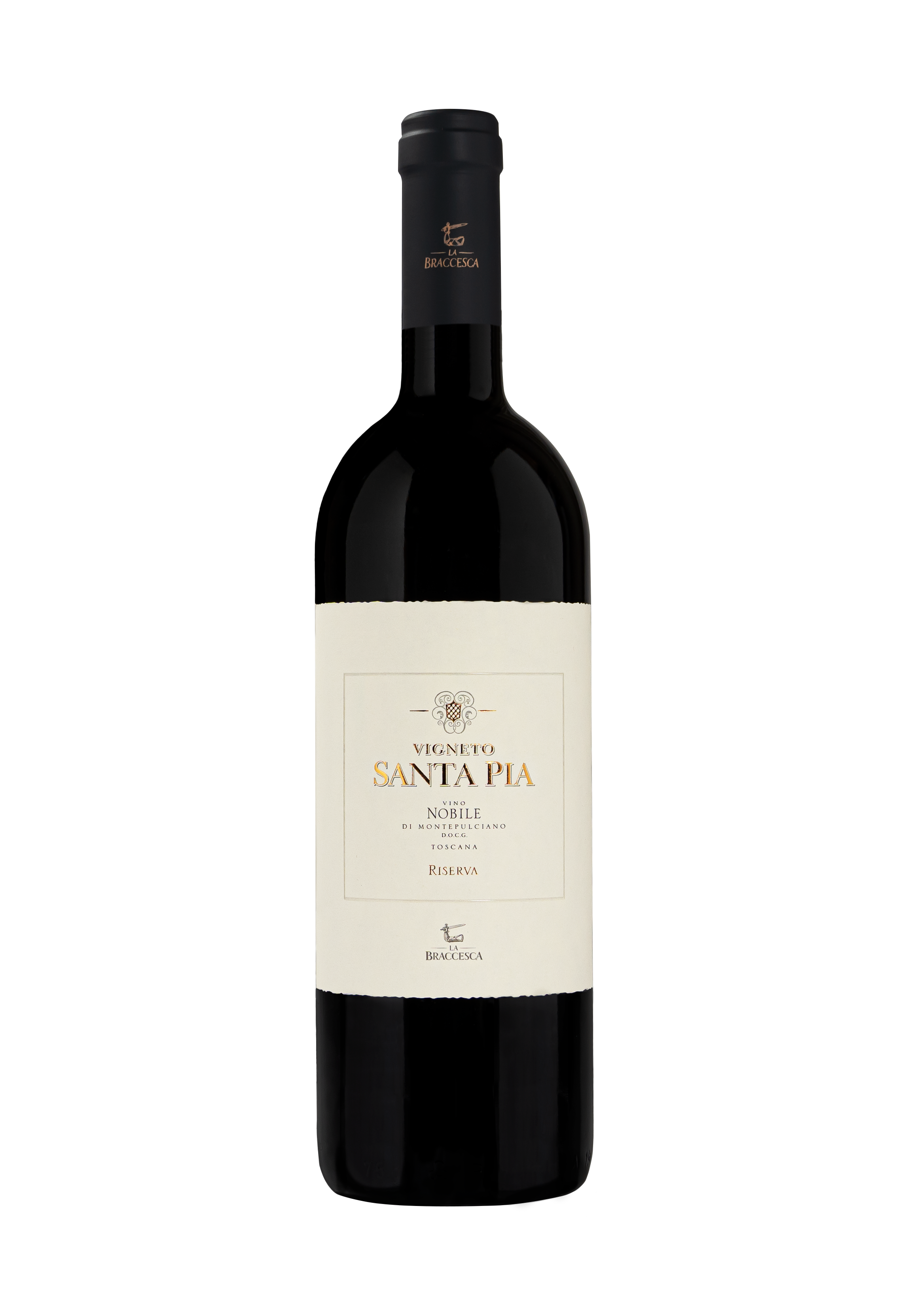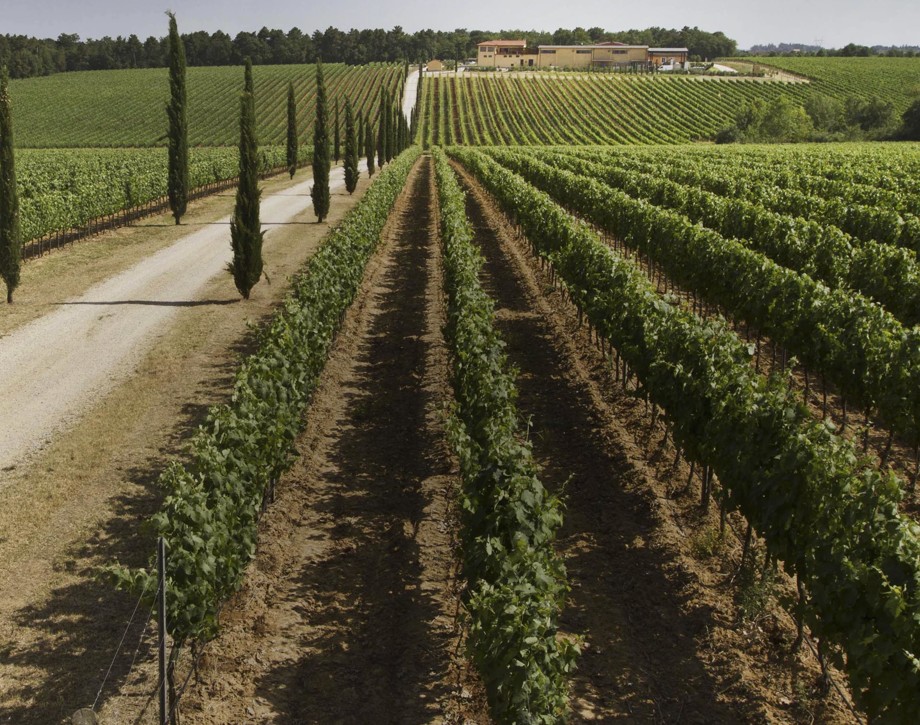Vigneto Santa Pia

Climate
Heavy rain in autumn 2003 enabled the soil layers to restabilize after the testing summer drought. The winter was cold and rainy with repeated fairly heavy snowfall. Thanks to the weather conditions, budbreak was delayed by 10-15 days even for more precocious varieties. During flowering and fruit-set, the weather was remarkably wet and cool (the lowest temperatures in the last 3-4 years). The vegetation developed well although with consistent delay through to veraison and ripening of the grapes. Intense pre-harvest selection was necessary because the weather conditions caused over-production. Lastly, the harvest began a couple of weeks later than average, when the grapes were perfectly healthy and ripe and showed a perfect balance of quantity and quality.
Vinification
Once fully ripe the grapes from the Santa Pia vineyard in the municipal area of Montepulciano were destemmed and softly crushed. Maceration lasted 20 days during which time the wine completed alcoholic fermentation at a maximum temperature of 30°C. It was then placed in French and Hungarian oak barriques where malolactic fermentation was completed. The ageing period in barriques lasted 14 months during which the wine was racked several times. It was bottled in early spring.
Historical Data
The La Braccesca estate covers some 1255 acres (508 hectares) where once were located the holdings of the Bracci counts, who gave their name both to the property and its count of arms: an armor-clad arm holding a sword. The overall vineyard surface consists of 850 acres (340 hectares) and is divided into two blocks: the first, 575 acres (233 hectares) is situated on the border between Montepulciano and the neighboring township of Cortona. The second, instead, 255 acres (103 hectares) insize, arrives close to the city itself and includes three highly renowned sub-zones for the production of outstanding red wine: Cervognano, Santa Pia, and Gracciano. Santa Pia is produced from a 37 acre (15 hectare) vineyard situated in the site of the same name, located the terraces below the town of Montepulciano. Its unique soil, medium in texture and consistence, rich in stones and sand, have assisted the ambition to produce an elegant, but at the same time classic, example of Sangiovese, one capable of transmitting the a highly recognizable expression of this historic production zone. The first year of production of Santa Pia was the 2001.
Tasting Notes
A vibrant, typically aromatic nose with red berry fruit notes and a hint of vanilla. The flavour is rounded, well-structured and balanced with sweet lingering tannins.

The Wine
Santa Pia is produced from a 15-hectare (37 acres) vineyard in an area called Santa Pia, located on the ridges just below the town of Montepulciano. This particular area has sandy loamy soils rich in rocky deposits known as “scheletro” that allow the Antinori’s to create an elegant yet traditional expression of the Sangiovese grape that reflects the characteristics of this historic winemaking area. The first vintage to be produced was 2001.

Climate
Heavy rain in autumn 2003 enabled the soil layers to restabilize after the testing summer drought. The winter was cold and rainy with repeated fairly heavy snowfall. Thanks to the weather conditions, budbreak was delayed by 10-15 days even for more precocious varieties. During flowering and fruit-set, the weather was remarkably wet and cool (the lowest temperatures in the last 3-4 years). The vegetation developed well although with consistent delay through to veraison and ripening of the grapes. Intense pre-harvest selection was necessary because the weather conditions caused over-production. Lastly, the harvest began a couple of weeks later than average, when the grapes were perfectly healthy and ripe and showed a perfect balance of quantity and quality.
Vinification
Once fully ripe the grapes from the Santa Pia vineyard in the municipal area of Montepulciano were destemmed and softly crushed. Maceration lasted 20 days during which time the wine completed alcoholic fermentation at a maximum temperature of 30°C. It was then placed in French and Hungarian oak barriques where malolactic fermentation was completed. The ageing period in barriques lasted 14 months during which the wine was racked several times. It was bottled in early spring.
Historical Data
The La Braccesca estate covers some 1255 acres (508 hectares) where once were located the holdings of the Bracci counts, who gave their name both to the property and its count of arms: an armor-clad arm holding a sword. The overall vineyard surface consists of 850 acres (340 hectares) and is divided into two blocks: the first, 575 acres (233 hectares) is situated on the border between Montepulciano and the neighboring township of Cortona. The second, instead, 255 acres (103 hectares) insize, arrives close to the city itself and includes three highly renowned sub-zones for the production of outstanding red wine: Cervognano, Santa Pia, and Gracciano. Santa Pia is produced from a 37 acre (15 hectare) vineyard situated in the site of the same name, located the terraces below the town of Montepulciano. Its unique soil, medium in texture and consistence, rich in stones and sand, have assisted the ambition to produce an elegant, but at the same time classic, example of Sangiovese, one capable of transmitting the a highly recognizable expression of this historic production zone. The first year of production of Santa Pia was the 2001.
Tasting Notes
A vibrant, typically aromatic nose with red berry fruit notes and a hint of vanilla. The flavour is rounded, well-structured and balanced with sweet lingering tannins.

Tenuta La Braccesca
The estate’s name comes from the historical farm that once stood there, owned by the Count of Bracci, whose coat of arms appears on the estate’s logo; an arm covered with armor brandishing a sword. Marchesi Antinori acquired the estate in 1990. The property extends over an area of 508 hectares (1255 acres) and the vineyards cover an area of 340 hectares (840 acres) divided into two blocks: the first is 366 hectares (904 acres) of which 237 (585 acres) are planted with vineyards and is located on the border between the cities of Montepulciano and Cortona. The other block is 142 hectares (350 acres) of which 103 (254 acres) are planted with vineyards, it extends all the way to Montepulciano encompassing three of the most famous parcels of land known for the production of great red wines: Cervognano, Santa Pia and Gracciano.

Soil
Sandy loam rich in very fine gravel.
















